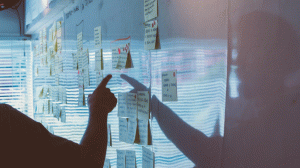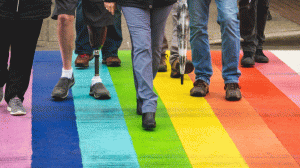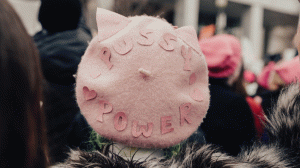Let me say it. It is okay to categorize people. One way or another, we have to orient ourselves. For example if a person seems suspicious to us, we trust our gut feeling and keep our distance. The crux of this so-called gut feeling is that we are always guided by our unconscious cognitive distortions of perception, better known as unconscious biases. We evaluate situations and people within fractions of a second, based on what we have experienced and learned (Domsch, Ladwig, Weber, 2019, p. 5).
For instance if we think of a person in a wheelchair, we sometimes associate helplessness with this group of people. Without our being able to influence it, these kinds of associations affect our emotions, which in turn influence our decisions. Most of this process happens unconsciously - and takes place in every brain. The business psychologist, Daniel Kahneman wrote about the unconscious formation of these prejudices: "The mental work that produces impressions, intuitions and many decisions takes place silently in our spirit (Kahnemann, 2012, p.14). He calls these systematic errors biases, which occur in a predictable way in certain circumstances.
If we know that we can be misled by our biases, does that we can no longer listen to our gut feelings? Are we not often proud of our healthy common sense and our years of experience in education and work? And how can one tell whether one is right with their "feeling"?
I believe that we can never really know. What we can do, however, is develop our awareness. Think of your mind as a drawer, be conscious about what you are placing in that drawer and be sure to leave some space in it. I remember my first anti-racism workshop for white people. I saw a homogeneous group in front of me, which I easily lumped together in one big pot. Privileged white people. That is to say I “read” the people as privileged and white. But what does “read” mean exactly?
When we see people, we automatically assign a category to them. If people see me for the first time, they probably read a heterosexual black cis-gender woman. Why? Heterosexual, because that is the norm, black because of my dark skin color and cis-gender woman (the sex attributed to me after my birth is the sex I identify with), because most people believe in binary sexes and see a woman in me. I could agree to this in almost all points, except one: I am not heterosexual. However, depending on who I am, people create other associations about me based on my attributes; foreigner, fugitive, does not understand German, socially weak...
Depending on how a person looks or speaks, we associate certain characteristics with them. These can be positive or negative - influenced by the identity, i.e. age, ethnic background, nationality, disability, gender, sexual orientation, or social class. As this (incomplete) enumeration shows, there are many different dimensions that make up every single person. So I am not only what people see at first sight, but also a mother, wife, student, entrepreneur, Rhinelander, passionate hobby cook, lactose intolerant, anti-racist and so much more. In order to learn these things about me, it is not enough to just look at me or listen to me briefly.
So what can we do when we meet strangers or supposed “homogeneous groups”? My suggestion would be to inhale, exhale and accept that we think the way we think. In the next step (and here it comes) we can try to become aware of what we are thinking and why. Why do we not like someone? Why do we think that this person is weak, strong, rich, poor, dangerous or harmless? If we think that maybe we are not quite right, we can just have a conversation with the person opposite us. How crazy would that be?
In my specific case, this means that I always try to approach foreign groups with the principle, "I only know that I know nothing". While working with the group, I see more and more clearly the different facets of each individual person. After some time together something wonderful happens. Despite the numerous differences, similarities gradually become visible. A white participant, for example, does not feel so white as a Jew, because she does not feel part of the white majority and is discriminated against by white Christians. Another participant says that as a single father, stereotypes and prejudices annoy him. Another participant has a non-visible disability and also feels a sense of disadvantage. All of a sudden the space filled with so many different people is no longer strange or scary, it becomes a place where I discover many similarities, and eventually feel that I belong and am understood.
If it is not so easy for us to get to know new people personally, there are other possibilities to gain insight into the life realities of different people and thus to gradually discard prejudices. We can read books or blog entries, watch documentaries and movies or follow different accounts in social media. In this way we also learn terms and self-designations that help us find a common language. The next time we meet new people, our fear of the 'new' and our inhibitions may be reduced.
We often read how important diversity and inclusion are. Have we really taken the time to find out what this means?
Doesn't it simply mean that we can be in a space where we are all different, but have many things in common? A space in which we are allowed to show vulnerability because we feel that we all have different facets? A space in which we are good as we are and feel a sense of belonging?
I believe that we can create such spaces in our professional life, as well as in our private lives. A good start is to inhale and exhale. Then we pause for a moment and consider whether we would like to go a step further and ask empathically, "Would you like to meet me for coffee or tea? I would like to get to know you better, because I believe we have more in common than we think".
About the Author
Ellen Wagner is a qualified hotel manager, business administration graduate, certified systemic coach and will complete her Master's degree in Business Psychology in 2021. She is an experienced intercultural trainer, author and lecturer. One of her main focuses is Diversity & Inclusion, with a special focus on racism and queer hostility. In 2019, she founded her company, cross cultural bridges - wagner coaching LLC in the United States to train, educate and empower people and businesses to understand diversity and live true inclusion. She also works on the transatlantic support of expatriates during the assignment process through intercultural training, empowerment workshops and 1-on-1 coaching.
Contact
Instagram: @crossculturalbridges
Website: www.cross-cultural-bridges.com
E-mail: ellen@cross-cultural-bridges.com
"to belonging" is a long-term project driven by tbd* that aims to change the discourse around diversity and inclusion to one of belonging. Anti-racism, feminism and equity will be the focus of our work and should lead to a radical systemic change in the impact sector, from "power over" and "power for" to "power with". This content series is a part of this project and was made possible by the Open Society Foundations (OSF). This article was originally published in 2020.










